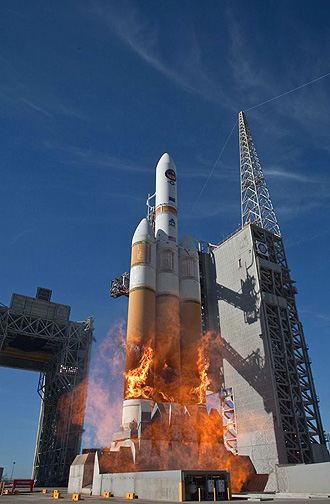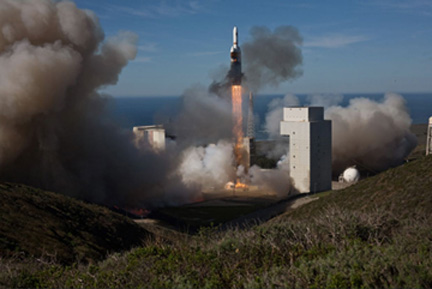
Vandenberg AFB, Calif., (Jan. 21, 2011) - A United Launch Alliance Delta IV Heavy launches with a National Reconnaissance Office payload at Space Launch Complex-6 at 1:10 p.m. PST. The Delta IV Heavy is the largest rocket ever launched from the west coast of the U.S. standing 235 feet tall and producing nearly 2 millions pounds of thrust at liftoff.
And so today, a United Launch Alliance Delta IV Heavy rocket carrying a payload for the National Reconnaissance Office (NRO) successfully lifted off from Space Launch Complex-6 at 1:10 p.m. PST. The Delta IV Heavy, at 235 feet or approximately 23 stories tall, is the largest rocket ever to launch from the West Coast of the United States. The mission is in support of national defense.
"Today’s launch was the second Delta IV Heavy launch for the NRO in two months and was also the largest rocket ever launched from the west coast,” said Jim Sponnick, ULA vice president, Mission Operations. “Most important is the critical NRO payload launched today which will significantly enhance the effectiveness and safety of the brave men and women defending our nation every day. Today’s successful launch represents the culmination of five years of hard work and exceptional skill in modifying the launch system to establish the west coast heavy lift capability for the nation and to integrate this important mission. I congratulate the combined NRO, Air Force, supplier and ULA team on this impressive accomplishment and successful launch.”

The Delta IV Heavy is America’s most powerful liquid fueled rocket. This was the fifth launch of a Delta IV heavy in program history. Photo by Pat Corkery, United Launch Alliance.
ULA's next launch is the Atlas V Orbital Test Vehicle-2 (OTV FLT 2) launch in support of the Air Force Rapid Capabilities Office (RCO) currently scheduled for March 4, from Space Launch Complex-41 at Cape Canaveral Air Force Station, Florida.
ULA program management, engineering, test and mission support functions are headquartered in Denver, Colorado. Manufacturing, assembly, and integration operations are located at Decatur, Alabama, Harlingen, Texas, and San Diego, California. Launch operations are located at Cape Canaveral Air Force Station, Florida, and Vandenberg Air Force Base, California.
Developed in partnership with the U.S. Air Force (USAF) Evolved Expendable Launch Vehicle (EELV) program, the Delta IV family of launch vehicles combines design simplicity, manufacturing efficiency, and streamlined mission and vehicle integration to meet customer requirements to launch high-priority USAF, National Reconnaissance Office (NRO), NASA, and commercial payloads to orbit. With operational launch pads on both coasts—Space Launch Complex-37 at Cape Canaveral Air Force Station, Florida, and Space Launch Complex-6 at Vandenberg Air Force Base, California—every Delta IV configuration is available to service the requirements of current and future satellite programs.
The Delta IV launch system is available in five configurations: the Delta IV Medium (Delta IV M), three variants of the Delta IV Medium-Plus (Delta IV M+), and the Delta IV Heavy (Delta IV H). Each configuration is comprised of a common booster core (CBC), a cryogenic upper stage and either a 4-m-diameter or 5-m-diameter payload fairing (PLF).
Since 1957, the Delta rocket, and its predecessor Thor, have carried satellites into orbit that have brought our world closer together and helped deepen our understanding of the universe.

